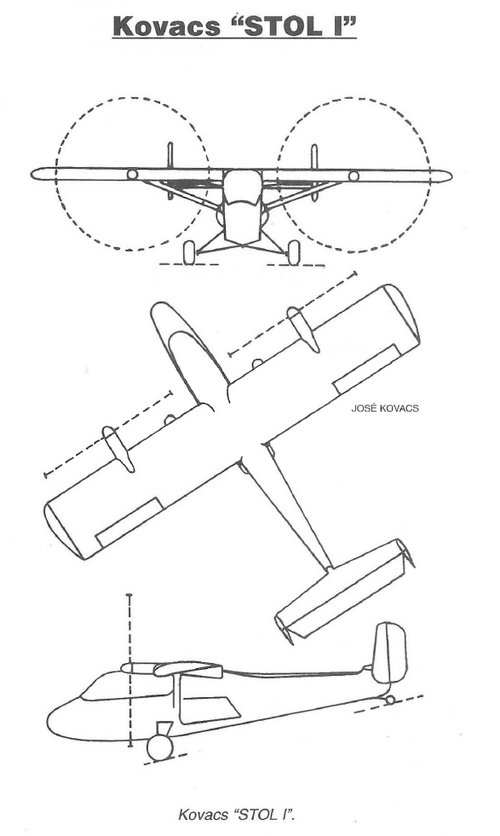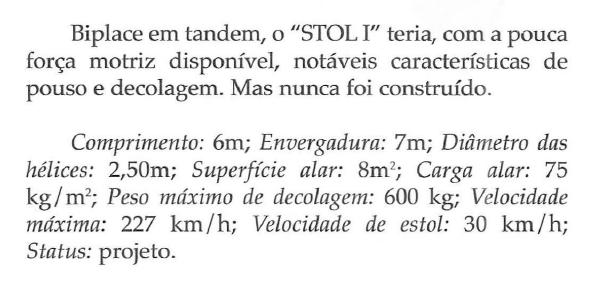- Joined
- 26 May 2006
- Messages
- 33,461
- Reaction score
- 13,494
From, Enciclopedia de Avioes Brasileiros,
Kovacs "STOL I"
In 1957, Eng. José Kovacs performed a series of
studies of light aircraft capable of short landings and take-offs (stol capacity). The idea was to get
such a result with a minimum of expense, in aircraft
of good performance and economical manufacture, inside
of what Kovacs defined as “minimal solution”.
The first of them, designated "STOL 1", had its
documentation sent to CTA on January 14th
of 1958 and was registered in the PAR. wooden aircraft,
with a high wing and double drift, the "STOL I" had a conventional fixed train and rigid uprights holding the wings
to the fuselage. The innovative technical solution, in this case, was
put the engine (conventional, 4-cylinder and 90 HP
power) embedded in the fuselage, behind the cabin,
at the center of gravity, driving the propellers (2, bi-blades,
one on each wing) through rigid tractor axles.
A transmission box coupled to the distrib-
was the strength.
Biplace in tandem, the "STOL 1" would have, with the little
available motive power, remarkable characteristics of
landing and taking off. But it was never built.
Length: 6m; Scope: 7m; Diameter of
propellers: 2.50m; Wing surface: 8m?; Wing load: 75
kg/m? Maximum takeoff weight: 600 kg; Speed
maximum: 227 km/h; Stall speed: 30 km/h;
Status: project.
Kovacs "STOL II"
In 1957, Eng. Kovacs designed some economical construction aircraft that allied high
performance at a low construction cost. An
of them would be powered by a conventional engine (see
Kovacs “STOL 1”). Another, called “STOL II”, would use a turbine (1 Turbomeca “Palas”, French). The "STOL II" plans were received by the CTA on 14th of
January 1958.
Of mixed construction (wood and metal), the "STOL
IH" was a tandem bi-seater, tricycle train, retractable,
with the turbine built into the lower part of the fuselage, behind the cabin, and the “V” rudder.
The most notable thing about the project was that with an engine
so weak (160 kg of thrust) the device would have great
performance, being also capable of short take-offs and landings (stall).
Although promising, the “STOL 1” project never
was achieved due to lack of resources of the designer and
official interest to finance the project.
Length: 5m; Span: 5.50m; Surface
wing: 3.96m; Total weight: 650 kg; Wing load: 164 kg/m;
Maximum speed: 690 km/h; Stall speed: 66
km/h; Status: project.
Kovacs "STOL I"
In 1957, Eng. José Kovacs performed a series of
studies of light aircraft capable of short landings and take-offs (stol capacity). The idea was to get
such a result with a minimum of expense, in aircraft
of good performance and economical manufacture, inside
of what Kovacs defined as “minimal solution”.
The first of them, designated "STOL 1", had its
documentation sent to CTA on January 14th
of 1958 and was registered in the PAR. wooden aircraft,
with a high wing and double drift, the "STOL I" had a conventional fixed train and rigid uprights holding the wings
to the fuselage. The innovative technical solution, in this case, was
put the engine (conventional, 4-cylinder and 90 HP
power) embedded in the fuselage, behind the cabin,
at the center of gravity, driving the propellers (2, bi-blades,
one on each wing) through rigid tractor axles.
A transmission box coupled to the distrib-
was the strength.
Biplace in tandem, the "STOL 1" would have, with the little
available motive power, remarkable characteristics of
landing and taking off. But it was never built.
Length: 6m; Scope: 7m; Diameter of
propellers: 2.50m; Wing surface: 8m?; Wing load: 75
kg/m? Maximum takeoff weight: 600 kg; Speed
maximum: 227 km/h; Stall speed: 30 km/h;
Status: project.
Kovacs "STOL II"
In 1957, Eng. Kovacs designed some economical construction aircraft that allied high
performance at a low construction cost. An
of them would be powered by a conventional engine (see
Kovacs “STOL 1”). Another, called “STOL II”, would use a turbine (1 Turbomeca “Palas”, French). The "STOL II" plans were received by the CTA on 14th of
January 1958.
Of mixed construction (wood and metal), the "STOL
IH" was a tandem bi-seater, tricycle train, retractable,
with the turbine built into the lower part of the fuselage, behind the cabin, and the “V” rudder.
The most notable thing about the project was that with an engine
so weak (160 kg of thrust) the device would have great
performance, being also capable of short take-offs and landings (stall).
Although promising, the “STOL 1” project never
was achieved due to lack of resources of the designer and
official interest to finance the project.
Length: 5m; Span: 5.50m; Surface
wing: 3.96m; Total weight: 650 kg; Wing load: 164 kg/m;
Maximum speed: 690 km/h; Stall speed: 66
km/h; Status: project.




